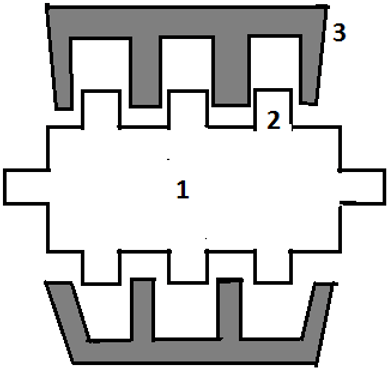This set of High Voltage Engineering Multiple Choice Questions & Answers (MCQs) focuses on “Electrostatic Generator”.
1. Electrostatic machine converts ________ to __________
a) electrical energy, mechanical energy
b) mechanical energy, electrical energy
c) electrical energy, thermal energy
d) thermal energy, electrical energy
View Answer
Explanation: Electrostatic machines are the devices that convert mechanical energy to electrical energy. Van de Graff generator is an example for electrostatic machine that converts mechanical energy into high voltage. They use variable capacitor principle.
2. An electrostatic generator consists of a stator with interleaved rotor vanes.
a) True
b) False
View Answer
Explanation: An electrostatic generator is an electrostatic machine. Electrostatic machines are the devices that convert mechanical energy to electrical energy. An electrostatic generator consists of a stator with interleaved rotor vanes and works on the principle of variable capacitance.
3. The current through a variable capacitor is ____________
a) \(I=\frac{dC}{dt}+C \frac{dV}{dt}\)
b) \(I=\frac{dV}{dt}+\frac{dC}{dt}\)
c) \(I=\frac{dC}{dt}+V \frac{dV}{dt}\)
d) \(I=\frac{dV}{dt}+V \frac{dC}{dt}\)
View Answer
Explanation: Electrostatic machines work on variable capacitor principle. The current through the capacitor that is variable is given by \(I=\frac{dV}{dt}+V \frac{dC}{dt}\) where C is the capacitor and V is the potential to which the capacitor is charged.
4. If \(\frac{dC}{dt}\) is negative ___________ is converted into _________
a) electrical energy, mechanical energy
b) mechanical energy, electrical energy
c) electrical energy, thermal energy
d) thermal energy, electrical energy
View Answer
Explanation: The current through the capacitor that is variable is given by \(I=\frac{dV}{dt}+V \frac{dC}{dt}\) where C is the capacitor and V is the potential to which the capacitor is charged. Hence, mechanical energy is converted to electrical energy when the term \(\frac{dC}{dt}\) is negative.
5. What is the power output when capacitor is charged with dc voltage?
a) \(P=V^2 \frac{dC}{dt}\)
b) \(P=C^2 \frac{dC}{dt}\)
c) \(P=C^2 \frac{dV}{dt}\)
d) P=0
View Answer
Explanation: The power input the circuit is given by the formula \(P=CV \frac{dV}{dt}+V^2 \frac{dC}{dt}\). Whenever the capacitor is charged with a dc voltage V, the power output is given by \(P=V^2 \frac{dC}{dt}\) since C \(\frac{dV}{dt}\) becomes zero.
6. In electrostatic machines, charged bodies are moved in _________ against the _________
a) electric field, magnetic field
b) magnetic field, electric field
c) electric field, electrostatic field
d) magnetic field, electrostatic field
View Answer
Explanation: The charge particles in the electrostatic machine are moved in an electric field against the electrostatic field. Thus the mechanical energy is converted into electrical energy. The mechanical power that is used to move the belt is converted into electrical energy.
7. In electromagnetic machines, current carrying conductors are moved in _________
a) electric field
b) magnetic field
c) electrostatic field
d) electric field or magnetic field
View Answer
Explanation: The current carrying conductors in an electromagnetic machine is moved in a magnetic field. Thus the mechanical energy is converted into electrical energy. The charge particles in the electrostatic machine are moved in an electric field against the electrostatic field to convert mechanical energy to electrical energy.
8. When the capacitor is applied a dc voltage, _________
a) C \(\frac{dV}{dt}\)=0
b) C \(\frac{dV}{dt}\)=Q
c) V \(\frac{dC}{dt}\)=0
d) V \(\frac{dC}{dt}\)=Q
View Answer
Explanation: The power input the circuit is given by the formula \(P=CV \frac{dV}{dt}+V^2 \frac{dC}{dt}\). Whenever the capacitor is charged with a dc voltage V, C \(\frac{dV}{dt}\)=0. Hence the power of the input circuit reduces.
9. What is the number of rotor poles in the machine if the frequency is 50 Hz and the speed is 1000rpm?
a) 12
b) 6
c) 10
d) 14
View Answer
Explanation: The equation to be considered here is np=120f where n is the speed of the generator in rpm, p is the number of rotor poles and f is the frequency.
1000*p=120*50
P=6.
10. Identify the elements in the given figure.

a) 1-rotor shaft, 2-rotor vanes, 3-stator vanes
b) 1-rotor vanes, 2-rotor shaft, 3-stator vanes
c) 1-rotor shaft, 2-rotor vanes, 3-stator vanes
d) 1-rotor shaft, 2-stator vanes, 3-rotor vanes
View Answer
Explanation: The figure represents an electrostatic generator. The elements are 1-rotor shaft, 2-rotor vanes, 3-stator vanes. The stator and rotor together forms the variable capacitor.
Sanfoundry Global Education & Learning Series – High Voltage Engineering.
To practice all areas of High Voltage Engineering, here is complete set of Multiple Choice Questions and Answers.
If you find a mistake in question / option / answer, kindly take a screenshot and email to [email protected]
